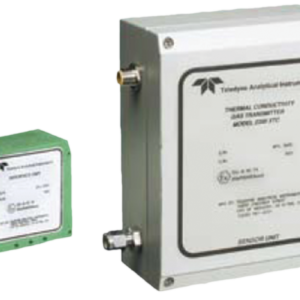The Series 2000 represents a complete line of Thermal Conductivity Detector (TCD) based analyzers which can be applied in a wide range of applications and industries. By using field proven filament-based and semiconductor based TC detectors, Teledyne is able to continuously monitor hydrogen and a variety of other gases of interest in either binary or multi-component sample gas streams.
- Brand
- DETAILS
- FEATURES
- SPECIFICATION
- APPLICATIONS
DETAILS
Series 2000 Platform
To contend with the numerous and varied analyzer requirements among industrial users, Teledyne has developed a feature rich, user-friendly platform. The Series 2000 comes with a standard software program incorporating such flexible features as (3) user-programmable ranges, automatic calibration, and customer selectable gas constituents.
Thermal conductivity is a basic property of gases that relates to their ability to conduct heat. Good conductors of eat such as H2 and He, have a high thermal conductivity whereas poor conductors of heat, such as CO2 and Ar, have low values. This ability to conduct heat forms the basis of detection. The Series 2000 analyzes gas compositions by continuously comparing the sample gas with a reference gas (sealed or flowing) of known thermal conductivity. This comparison is performed in a 2 chamber detector cell block. Reference gas occupies one chamber and sample gas the other.
A pair of temperature-sensitive heated filaments is mounted in each chamber. These filaments are part of a Wheatstone Bridge circuit. Should the sample gas composition change, its thermal conductivity will also change, conducting different amounts of heat away from the sample gas filaments. Since the resistance of the filaments is a function of their temperature, the resistance changes when the sample gas changes.
Any such change results in an imbalance in the Wheatstone Bridge, resulting in an electrical signal proportional to the change. Since the temperature of the filaments is tightly temperature controlled, the Series 2000 provides an accurate measure of any change in the sample gas composition. Teledyne offers this cell design in a variety of wetted parts to contend with corrosive gas streams typically found within the hydrocarbon processing industry.
Sensor Operating Principle
The thermal conductivity sensor measures the concentration of a specific gas between a hot surface resistor and an ambient temperature reference resistor using the thermal conductivity coefficient of the gas itself.
Sensor Description
The sensor structure consists of an integrated heater located on a thin electrical and thermal insulating membrane. Two thin film resistors are used for heating and measuring the temperature of the membrane. Two resistors are integrated on the silicon beside the membrane for the compensation of the ambient temperature changes.
Gases which have a lower density than air (CH4) cause a decrease on the surface membrane temperature. On the other hand, gases with densities heavier than air (CO2) increase the temperature of the measuring resistor.
Options
- C Integrally mounted auto-calibration valving
- H Stainless steel cell block with gold filaments (for gas streams with H2S)
- K 19″ rack mount for 2000A
- L Gas selector panel for sample and cal gas selection and flow control
- N 220 VAC operation
- R Sealed reference (for filament-based TCD)
FEATURES
- Three programmable ranges plus cal range
- Isolated 4-20 mADC and 0-1 VDC output signals
- Range ID contacts (4) Form A normally open
- Two fully adjustable concentration alarm set points with programmable relay function Form C contacts
- Programmable auto calibration capability with mode ID Form A normally open contacts
- Remotely operated calibration capability (customer-supplied valves and 24 VDC signal)
- Self-diagnostics with Form C failure alarm contacts
- Full duplex RS-232 communication link for remote control of all functions including range change, alarm settings, cal/zero and diagnostics
- Five digit gas concentration LED display
- Backlit 2 x 20 line alphanumeric vacuum fluorescent for set up and diagnostics
- 316 stainless steel sample passages
- Nickel-plated cell block with nickel filaments
- 115 or 220 VAC operation (customer to specify at time of order)
- Explosion proof housing: U/L and CSA listed enclosure for Class 1, Div 1, Groups B, C & D service NEMA 4/7 rated
- FM Approved for use in Class 1, Div 1, Groups B, C & D when used with specified flame arrestors (see options)
- NEC and ATEX rated configurations
SPECIFICATION
| Mounting | Wall |
| Area Classification | Fully explosion proof, FM approved for Class 1, Div 1, Groups B, C and D; CENELEC versions available |
| Ranges | Three ranges plus a cal range, field selectable within limits (application dependent) and auto ranging |
| Display | Backlit 2 line alphanumeric LCD; 5 digit LED display |
| Accuracy | ± 1% of full scale for most binary mixtures at constant temperature ± 5% of full scale over operating temperature range once temperature equilibrium has been reached |
| Response Time | 90% in less than 10 seconds with a flow rate of 100 sccm |
| Temperature | 32° to 122°F (0° to 50°C) |
| Sensor Type | Standard TC cell (4-filament detector) |
| Signal Output | Two 0-1 VDC (concentration and range ID) Two 4-20 mADC isolated (concentration and range ID) |
| Alarm | Two fully programmable concentration alarm set points and corresponding Form C, 3 amp contacts One system failure contact to detect power, calibration, zero / span and sensor failure |
| Cell Material | Nickel plated brass block with nickel alloy filaments and stainless steel piping and end plates |
| O/P Interface | Full duplex RS-232 |
| Max Load Impedance | 1000 ohms |
| Reference Gas | Sensor selection dependent. Semicon-based = sealed Filament-based = flowing or sealed (app. dependent) |
| Tube Connections | 1/4″ compression fittings, 6 mm adapters optional |
| Wetted Parts | Stainless steel, nickel and gold (gold filament option) |
| Sample Gas Flow Rate | Recommended 0.1 to 0.4 SCFH |
| Power Requirements | 110 VAC, 50-60 Hz (220 VAC optional) |
| Zero/Span Drift | ± 1% of FS |
| Pressure | 5-50 psig |
APPLICATIONS
Air Separation
- Bulk gas purity monitoring
- Gas mixture blending
- Breathable diving gases
- Calibration gas blends
- Specialty gas cylinders for SF6, laser gas mixtures, etc.
Petrochemical and Refinery
- H2 purity monitoring in recycle gas streams
- Redesulfurization process
- H2 reformer process
- Tail gas treatment units
- HYCO Syngas monitoring
- UOP (CCR) N2 header, lift gas H2 / HC safety analysis
Turbine Generators
- Hydrogen purity analysis of purge cooling gas in the turbine generator housing to detect possible seal leaks
Nuclear Power Generation
- Hydrogen detection in the Containment Building in the event of a loss of coolant accident (LOCA) or steam line break (SLB)
Steel / Heat Treating
- Annealing furnace blanket gas monitoring
- Blast furnace monitoring
- Basic oxygen monitoring for process control purposes







